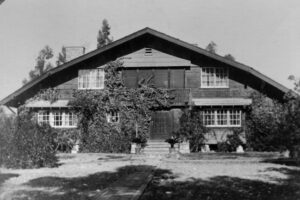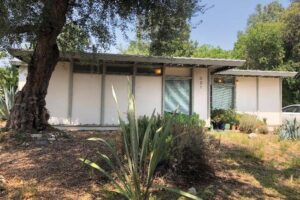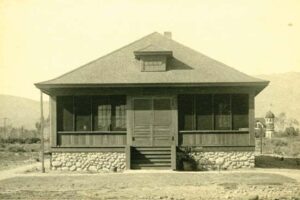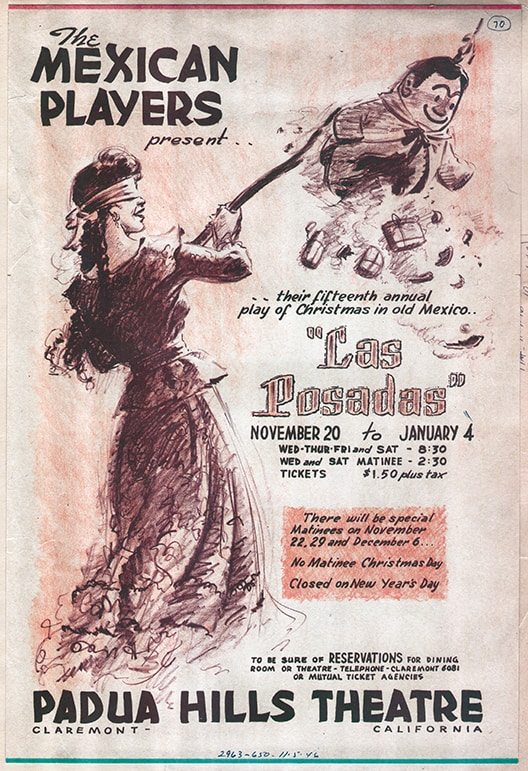What makes a property historic?

The Darling/Wright house is the only home in Claremont designed by renowned architects Charles and Henry Greene. Photo/courtesy of Claremont Heritage
by John Neiuber
The word “history” comes from the Greek word “historia,” which means “inquiry” or better stated, “knowledge from inquiry.” This is fitting because for a property to receive the designation “historic,” it requires inquiry and documentation.
Whether a property is listed on the local Claremont Register of Structures of Historic or Architectural Merit, the California Register of Historical Resources, or the National Register of Historic Places, they must meet the common criteria all three registers share.

The Darling/Wright house is the only home in Claremont designed by renowned architects Charles and Henry Greene. Photo/courtesy of Claremont Heritage
The local, state, and national criteria for designating a property as historic are the same save for minor differences, but for our purpose here we will explore the national criteria. This is where the idea of “knowledge from inquiry” comes into play. Not everything old is historic. Generally, if we are talking about a building it must be 50 years or older and retain its historic features to qualify. A building may or may not be architecturally significant but is historic because an event of importance occurred there, or a historically significant person was associated with the site.
The U.S. Department of the Interior is responsible for setting the criteria to evaluate cultural resources for inclusion in the National Register of Historic Places. It issues the National Register Bulletin, that contains the criteria and process for designation.
The criteria are broad enough to address the wide variety of historic properties associated with our history and to help evaluate the significance of “districts, sites, buildings, structures, and objects that possess integrity of location, design, setting, materials, workmanship, feeling, and association, and:
- That are associated with events that have made a significant contribution to the broad patterns of our history; or
- That are associated with the lives of persons significant in our past; or
- That embody the distinctive characteristics of a type, period, or method of construction, or that represent the work of a master, or that possess high artistic values, or that represent a significant and distinguishable entity whose components may lack individual distinction; or
- That have yielded, or may be likely to yield, information important in prehistory or history.”
In Claremont, the Intercultural Council Housing located at First Street and Claremont Boulevard is an example of criterion A and is listed on the National Register of Historic Places. The homes themselves are modest International Style dwellings, but the main significance is that they were constructed in 1947 as a solution to poor housing, segregation and discrimination issues in Claremont and California. It was championed by the Intercultural Council of the Claremont United Church of Christ. Most of Claremont at that time was under restrictive covenants. The ICC was able settle six Mexican American families, five white families and one Black family in the Intercultural Council Housing, making it one of the first integrated housing developments in the state, long before housing laws changed.

The Intercultural Council Housing at First Street and Claremont Boulevard was the first integrated housing in Claremont. Photo/courtesy of John Neiuber
Criterion B is found in The Helen Goodwin Renwick House on College Avenue at Second Street. It is an example of late Victorian architecture, but more importantly is associated with Renwick, whose gifts to Pomona College were important in its development, and because her gift of land to the city was responsible for the development of the civic center, city hall, the library that today bears her name, and the post office.
A modest structure on Harrison Avenue, the Phebe Spalding House, now used as Claremont United Church of Christ’s Early Childhood Center, is another example of criterion B. Spalding is an important historical figure in Claremont who contributed to the cultural fabric of Pomona College and the community. She earned her Ph.D. from Boston University in 1908. A professor, academic, and author of many books, she was an inspiration to students and hosted many at her home, which they called “otherwhere.”
To see a fine example of criterion C, one needs to look no further than the Darling/Wright House at College Avenue and Eighth Street. The home, designed by Charles and Henry Greene, is the work of master architects. The chalet style Craftsman home is the only Claremont structure designed by Greene and Greene and earned them accolades and awards early on in their careers.

The historic Phebe Spalding House on Harrison Avenue is today used as Claremont United Church of Christ’s Early Childhood Center. Photo/courtesy of Claremont Heritage
Criterion D could be almost any area where an archaeological dig or a construction site may likely yield information important to the prehistory or history of Claremont. For example, construction in the Village area could yield artifacts of structures once at the site, or in and around the mesa where the California Botanic Garden is located could yield information about Indigenous tribes.
Not every historic resource in a community is listed on the national register. Nearly all historic structures in Claremont are listed on the local register. To be designated as or considered to be historic, a property need only meet one of the criteria.










0 Comments